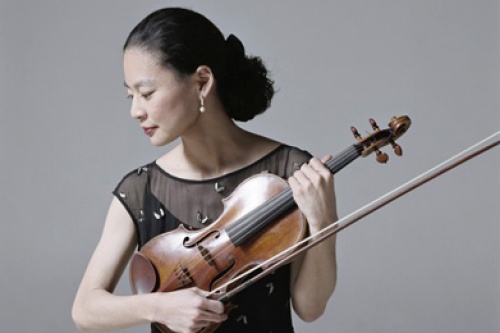Midori and pianist fail to strike sparks with bland and cool performances

Midori and pianist Özgür Aydin performed a recital Sunday at Symphony Hall for the Celebrity Series of Boston.
During much of the recital by violinist Midori and pianist Özgür Aydin Sunday afternoon at Symphony Hall, one was reminded of those maddening straight-A students who always carry out their assignments perfectly, but without a shred of imagination.
So, what’s not to like about a silver thread of violin tone that curls exquisitely around a phrase? Or two artists that have so perfected their ensemble that they seem to have a single heartbeat? Or flying fingers that overcome all difficulties with poise and elegance? Midori and Aydin earned all A’s for these, and much more.
Give another A for the brave and substantial program, presented by the Celebrity Series of Boston, consisting of three big, bold Beethoven sonatas separated by interludes of evanescent music by Anton Webern and George Crumb.
From Beethoven’s ten sonatas for violin and piano, the artists picked the three that are in the key of A major, which made an interesting mini-series of the early Op. 12, No. 2, the transitional Op. 30, No. 1, and the full-blown heroic Beethoven of Op. 47, the Kreutzer Sonata.
To look back and see that the earlier sonatas represented stages on the road leading to the Kreutzer is perfectly legitimate. But to play them as though they’re small beer and don’t deserve much engagement by artist or listener is to replace the composer’s point of view with one’s own, and to miss the point of the music. Better to give each piece all you’ve got, as Beethoven himself did, and let the comparisons fall where they may.
Midori and Aydin’s cool, finely polished renderings of the first two Beethoven works displayed their straight-A skills to advantage—the tonal range, the attention to detail—without ever catching Beethovenian fire. The slow movements lacked the profound, aching emotion characteristic of Beethoven’s adagios at every stage of his career, and the variations finale of Op. 30, No. 1 grew tedious from lack of spark and contrast.
In these works, pianist Aydin played mellifluously but in general too deferentially, failing to strike any sparks with the violinist. There is still enough of the old-fashioned “pianoforte sonata with violin accompaniment” about these works to require that the pianist seize the advantage often, not just follow along.
If these performers’ Beethoven had been more convincing, it would have given them the credibility to win the audience over to the comparative novelties of Webern and Crumb. As it was, their intense concentration on the tiny, dry brushstrokes of Webern’s Four Pieces, Op. 7 and Crumb’s Four Nocturnes (Night Music II) evoked more admiration for the players than enjoyment of the brief, elusive pieces.
Still, one got a good sense of the cogent style of Webern, who famously said he would like to write longer pieces, but each idea seemed to work itself out completely after a minute or two.
Crumb, for his part, once said he grew up in small-town America liking and playing all kinds of music, but especially Beethoven. While Crumb’s compositions don’t sound at all like Beethoven, he shares with the old master a yearning for radically new sounds in music, many of which—inside-the-piano plucks, mutings, distant thunder, and literal brushstrokes (with a drummer’s brush), along with violin-slapping percussion—were on display in the Four Nocturnes, sensitively executed by Sunday’s performers as they evoked Crumb’s fantastic night world.
To go from Crumb’s fleeting visions to a Beethoven sonata that begins with the violin playing alone was an intriguing choice, made moot by Midori’s prosaic rendering of the Beethoven solo. However, once the initial Presto of the Kreutzer began to assert itself, it finally became clear that these two musicians had come to play.
Without losing their fundamental polish and elegance, Midori and Aydin began to push each other more. The pianist let loose with some startling sforzandos, and it was good to see a couple of broken horsehairs waving from Midori’s bow as she charged through the first movement.
Beethoven, the great exponent of variation form, was not at his best in the variations movement of the “Kreutzer”—or at least so it seemed as pianist and violinist rolled through variation after variation, missing the humor of one and the minor-key melancholy of the next, until this movement too began to seem awfully long.
Humor also seemed to elude the performers in the Presto finale, but most of the movement was about speed, force and energy anyway, and the duo supplied those in abundance, with a pinpoint coordination that made it all the more exhilarating.
Midori and Aydin responded to the enthusiastic applause with two encores: Debussy’s piano prelude La fille aux cheveux de lin, arranged for violin and piano by Arthur Hartmann, and Tambourin chinois by Fritz Kreisler. Midori’s vanishing tone in the Debussy would no doubt have delighted George Crumb, had he been present.
The next classical event in the Celebrity Series of Boston will be the Takács Quartet with pianist Marc-André Hamelin 8 p.m. November 16 at New England Conservatory’s Jordan Hall. celebrityseries.org
Posted in Performances



